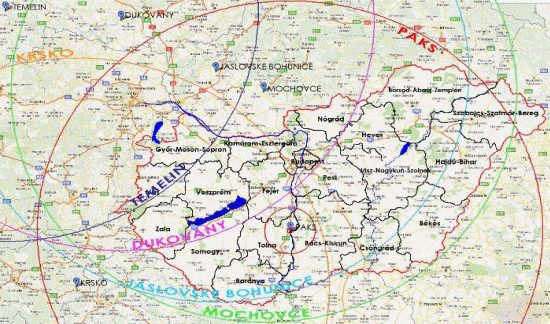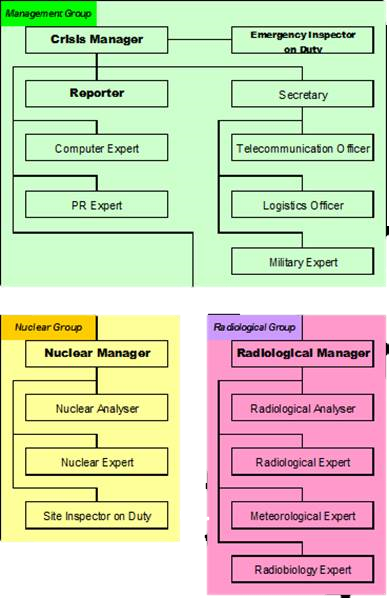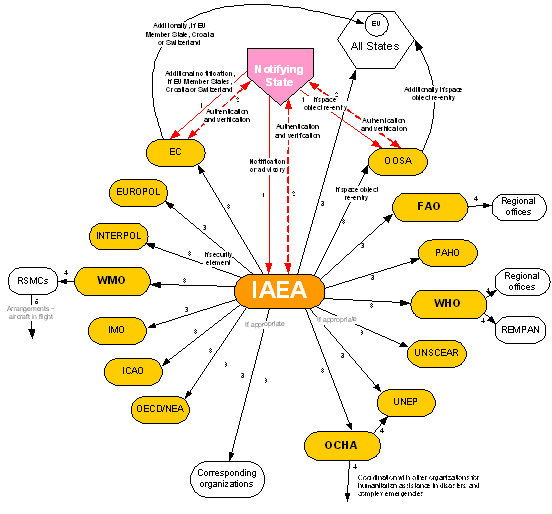INTRODUCTION
The International Atomic Energy Agency (IAEA) provides for the application of standards and, under the terms of Articles III and VIII.C of its Statute, makes available and fosters the exchange of information relating to peaceful nuclear activities (with nuclear and radiological emergency preparedness), as well as it serves as an intermediary among its Member States for this purpose. Designated authorities, or organizations responsible for the management of emergencies recognize that good preparedness in advance of any emergency can substantially improve the emergency response[1]. It is an international expectation that IAEA member states (and its authorities) meet this IAEA general requirement. This is especially important after the Fukushima Dai-ici accident.
In Hungary the Hungarian Atomic Energy Authority (HAEA) embodies the guarantee of the peaceful and safe use of atomic energy for the Hungarian society (and indirectly for the citizens of neighbouring countries). It is the responsibility of the HAEA to guarantee safety complying with international standards and recommendations, adhering to and complying with national standards. The HAEA is independent from all organizations involved in the development and technical support of nuclear energy, which is a fundamental requirement for national and international organizations. Figure 1 shows how Hungarian issues of complex international effects.
The responsibility of the authority is to supervise safety and protected applications, to prepare regulations in accordance with the results of science and technology, to make the licensee observe the requirements of the law, to ensure the conditions provided by the Hungarian Parliament and Government, and to establish and operate a competent and effective regulatory body within the legal framework. Security, safety and safeguards can have several meanings in the energy sector. Security of the energy supply; protection or security (physical protection) and peaceful uses (i.e. the user is not building nuclear weapons) are various aspects of security. Safeguards are measures that guarantee the peaceful use of nuclear energy and prevent the proliferation of nuclear weapons. Nuclear protection (physical protection) security means protection against deliberate human action. The protection against the harmful effects of the ionizing radiation is called nuclear safety – the protection of the environment, as well as people (both the general public and employees) and all living things from the harmful effects of ionizing radiation.
Emergency response is an important task of the HAEA, which is independent from nuclear facilities, but integrates all the regulatory fields. Operating an Emergency Response Organization within the HAEA which is internationally acknowledged and meets the IAEA standards and requirements was a major challenge.
TASK OF THE AUTHORITY
REQUIREMENTS
The HAEA is a supervisory body in the field of accident management programmes and emergency response systems of nuclear facilities. The IAEA Safety Guides[3 4] provides recommendations for the development and implementation of an accident management programme to meet the requirements for accident management that are established in the publications.
Accident management, including severe accident management, is therefore an essential component of the application of defence in depth. Accident management complements the operating procedures that must be developed for normal operation, anticipated operational occurrences and accident conditions, as stated in the IAEA Guide[4]. The operating organization of the power plant shall establish, periodically review and as necessary revise the accident management program. The accident management program has to integrate accident management guides, too. The accident management guidance should be an integral part of the overall emergency arrangements and should be coordinated with the on-site emergency plan, established in accordance with the IAEA publication[4 5], as well as the national legislation and authority requirements.
OFFICIAL DUTIES
The main tasks of the HAEA are licensing, assessment, inspection and enforcement. Licensing is one of the most responsible areas for the authority’s activity. The license is always based on a safety analysis to demonstrate the guarantee of nuclear safety, while relevant regulatory requirements and special requirements[5] are taken into account. The emergency response and action plans, as well as the accident management guides of nuclear facilities are licensed by the HAEA.
Inspection takes places during the realization of the activity; it reveals the facts and circumstances of the activities and it gives opportunity for intervention in the implementation phase. The Authority is involved in all nuclear emergency response exercises and drills. Sometimes this participation is only an administrative role, but in case of the annual comprehensive drills the HAEA ERO is activated as well.
The authority performs the assessment typically during an activity or a process, so the conclusions are drawn subsequent to the completion of the activity.
Licensing, inspection and assessment are not fully separate activities: they may and frequently must supplement each other for the appropriate oversight of a certain case.
Enforcement means imposing fines or withdrawal of license, and this is the ultimate possibility to enforce the legal requirements and regulatory point of view.
The task of the Authority is to take part in the nuclear emergency response and preparedness system and to operate an Emergency Response Organization. According to the Atomic Act[6] and the relevant Governmental Decree[7] several tasks belong to the HAEA in the field of nuclear emergency preparedness and response.
THE IMPLEMENTATION OF PREPAREDNESS IN HAEA
THE HUNGARIAN NUCLEAR EMERGENCY RESPONSE AND PREPAREDNESS SYSTEM (NERS)
The national nuclear emergency response system takes care of preparations to respond to radiological and nuclear events occurring in the course of the peaceful use of atomic energy. The NERS is responsible for the mitigation and reduction of the consequences of any incidents.
The NERS operates in normal or, in some cases, in higher operational states, which can be readiness, alert, emergency and recovery operation. The normal state ensures the preparation for incidents. The readiness operation state is the sum of radiation protection activities applied in incidents that do not exceed the emergency threshold. It covers incidents that occur in a foreign country (in a nearby nuclear facility) and cause a radioactive release, or the risk of release is high, or an exposure occurred in Hungary, but the emergency threshold is not exceeded, although the risk of radioactive release is high. The operational state can be changed from the normal state, for example, if an incident occurs in a facility that uses radioactive materials, such as exposure in a hospital. In the emergency operations state, protective actions must be introduced in order to decrease the resident population’s exposure or risk of exposure to radiation[8-10].
The NERS is the totality of central, ministerial, territorial and local level organizations and bodies concerned in the prevention, mitigation of consequences and elimination of event causing unplanned radiation exposure to the public.
The governmental coordination body tasked with disaster management-related decision support to the government directs the NERS. The operational state of the NERS can be changed by the Minister of Interior, who is responsible for disaster management. The head of the HAEA can initiate this change with the head of the professional disaster management organization.
The NERS is responsible for supporting the decision making of the governmental coordination body in the field of protective actions as well.
MINISTRIES PARTICIPATING IN THE NERS
Ministry of the Interior, Ministry of Human Capacities, Ministry of Defence, Ministry of Foreign Affairs, Ministry of National Economy, Ministry of National Development, Ministry of Rural Development are represented at the ministerial level in the NERS. The Minister of the Interior is the chair of the Coordination of Disaster Management.
INDEPENDENT ADMINISTRATIVE BODIES AND MINISTRY DEPARTMENTS
The following independent regulatory organizations, national law enforcement organizations and ministry departments also participate in the NERS: the Hungarian Atomic Energy Authority, the National Directorate General for Disaster Management, the National Food Chain Safety Office, the National Office of the Chief Medical Officer, the Hungarian Defence Forces, the Hungarian Police Headquarters, the National Tax and Customs Office, the General Directorate of Water Management, and Pest County Government Office (as national environmental protection authority).
REGIONAL AND LOCAL PARTICIPATION
Local defence committees coordinate the response at the regional level and inform the public in the region. Town mayors coordinate the response within their jurisdictions, and other local organizations supports the NERS decision making.
In accordance with the recommendations of the IAEA, Hungary issued the National Emergency Response Plan in 2002. In 2017 the third edition was issued. The goal of the National Nuclear Emergency Response Plan is to summarize all those requirements and tasks that have importance in achieving basic goals in off-site response to a nuclear emergency due to the use of atomic energy affecting the territory of Hungary. The Hungarian NERP provides a framework and guidance to prepare the central, departmental, regional, local and facility emergency response plans and preparedness. The HAEA ERO (see next section) is involved in the NERP approval sequence.
OPERATION OF THE HAEA EMERGENCY RESPONSE ORGANIZATION
The HAEA operates an Emergency Response Organization (ERO) that maintains close liaison with the NERS (see the organizational diagram, Figure 2.) The ERO is a contact point both to international organizations and to nuclear facilities. It is also a competent authority, based on Hungary’s EU membership and the international conventions on early notification and assistance in the case of nuclear emergency. The ERO is responsible for the assessment of nuclear and radiological conditions during an emergency.[8-10]
HAEA experts operate the Centre for Emergency Response, Training and Analysis (CERTA), and this is the operational location for the ERO. It is designed for monitoring and analysing the nuclear and radiological emergency and for supporting the decision making process by making simulations and nuclear / radiological assessment.
ERO’s Nuclear group is responsible for nuclear analyses, the Radiological group is responsible for radiological analyses and the national radiological monitoring systems, while the Management group is responsible for the coordination and the approval of the subordinated groups’ reports. The Crisis Manager, as the final approval authority, is responsible for all documents formulated and dispatched by the ERO.
The Emergency Officer on Duty is the contact point with external organizations, and he supports the work of the ERO. The Site Inspector on Duty delegated to the emergency organization of the Hungarian Electricity Works (Magyar Villamos Művek – MVM) at the nuclear power plant in Paks collects the on-site information.
One of the tasks of the HAEA Nuclear Safety Inspector on Duty is to receive the nuclear and radiological event notifications from locations within Hungary. He is on standby around the clock to receive fax or phone notifications. The notifications of nuclear emergencies from abroad, on the other hand, are received by the Emergency Inspector on Duty. The two duty officers are equipped with smart phones, via which they can send and receive fax and email messages and initiate phone calls. The Nuclear Safety Officer on Duty records the incoming reports and takes appropriate actions under his own authority in case of less significant incidents (which occur more frequently), while in an emergency he informs the Crisis Manager on Duty.
Subsequent to the decision on alerting of the HAEA ERO due to an exercise or real emergency, the notification goes through the organization according to the pre-established alert-chain.
INTERNATIONAL COOPERATION
The purpose of the international co-operation is to improve the efficiency of regulatory instruments and the effectiveness of the activity by exchanging experiences and understanding international conventions, codes, safety requirements, recommendations, guides, training courses and international good practice. Each Member States of the IAEA is responsible for conducting a periodic review of its emergency preparedness and response capabilities. The IAEA has guidelines for states and international organizations to develop arrangements to interface with the IAEA and with the other member states in case of a nuclear or radiological incident or emergency[11]. The IAEA has interagency framework for preparedness for and coordinated response to nuclear or radiological incidents and emergencies[12]. This Joint Radiation Emergency Management Plan (JPLAN) defines the co-operation among organizations on an international level (European Commission, Police of the European Union – EUROPOL, Food and Agriculture Organization – FAO, IAEA, International Civil Aviation Organization – ICAO, INTERPOL, International Maritime Organization – IMO, OECD Nuclear Energy Agency – OECD-NEA, Office for the Coordination of Humanitarians Affairs – OCHA, United Nations Scientific Committee on the Effects of Atomic Radiation – UNSCEAR, World Health Organization – WHO and Wold Meteorological Organization – WMO). The IAEA has a task to coordinate the response to nuclear or radiological emergencies, the OCHA coordinates humanitarian response, the WHO and PAHO coordinates public health response and IAEA member states responsible for the international assistance and release of public information. The structure of the JPLAN is shown in Figure 3.
The IAEA has a coordinator role, in case of a nuclear and radiological emergency on an international level.
The IAEA triggers the activation of the system, receives notifications of emergency, acts as the focal organization for response coordination, and coordinates international assistance.
Hungary is a member of the IAEA operated Response Assistance Network (RANET). The HAEA has a role as a national coordinator among the Hungarian assistance organizations. In 2011 RANET has 19 countries with registered capabilities.
The legal framework of international cooperation in the field of nuclear emergency response is provided by the conventions on early notification[11] and mutual assistance in case of a nuclear or radiological emergency, which were established under the auspices of the International Atomic Energy Agency and the Euratom directive on the community regulations concerning early information exchange in radiological emergencies. According to the international requirements for the receipt of early notifications and the dispatch of such notification in a timely manner in case of domestic emergencies, the HAEA operates its competent authority duty system on a 0-24 basis. There is international cooperation on nuclear emergency management. Based on this convention the IAEA’s Unified System for Information Exchange in Incidents and Emergencies (USIE) system is used for early notification, and the RANET system is used for mutual assistance in the case of nuclear or radiological emergency.
Hungary concluded bilateral agreements with Austria, the Czech Republic, Croatia, Germany, Romania, Slovakia, Slovenia, Ukraine and Serbia to notify each other of nuclear or radiological emergencies in the early phase of such situations and assist each other should such a request be received. The bilateral cooperation agreements provide good opportunities to share experiences, organize joint exercises and elaborate the framework of joint activities.
CONCLUSION
In the framework of RESPEC (Radiological Emergency Support Project for the European Commission) the HAEA has become a supporting organization, delegating experts who analyse radiological events in the radiation protection section in radiological or nuclear emergency situations. The HAEA ERO has won RESPEC tenders three times to perform
support tasks. The HAEA was activated and supported the European Commission successfully during the Fukushima Daiichi Accident in 2011.



